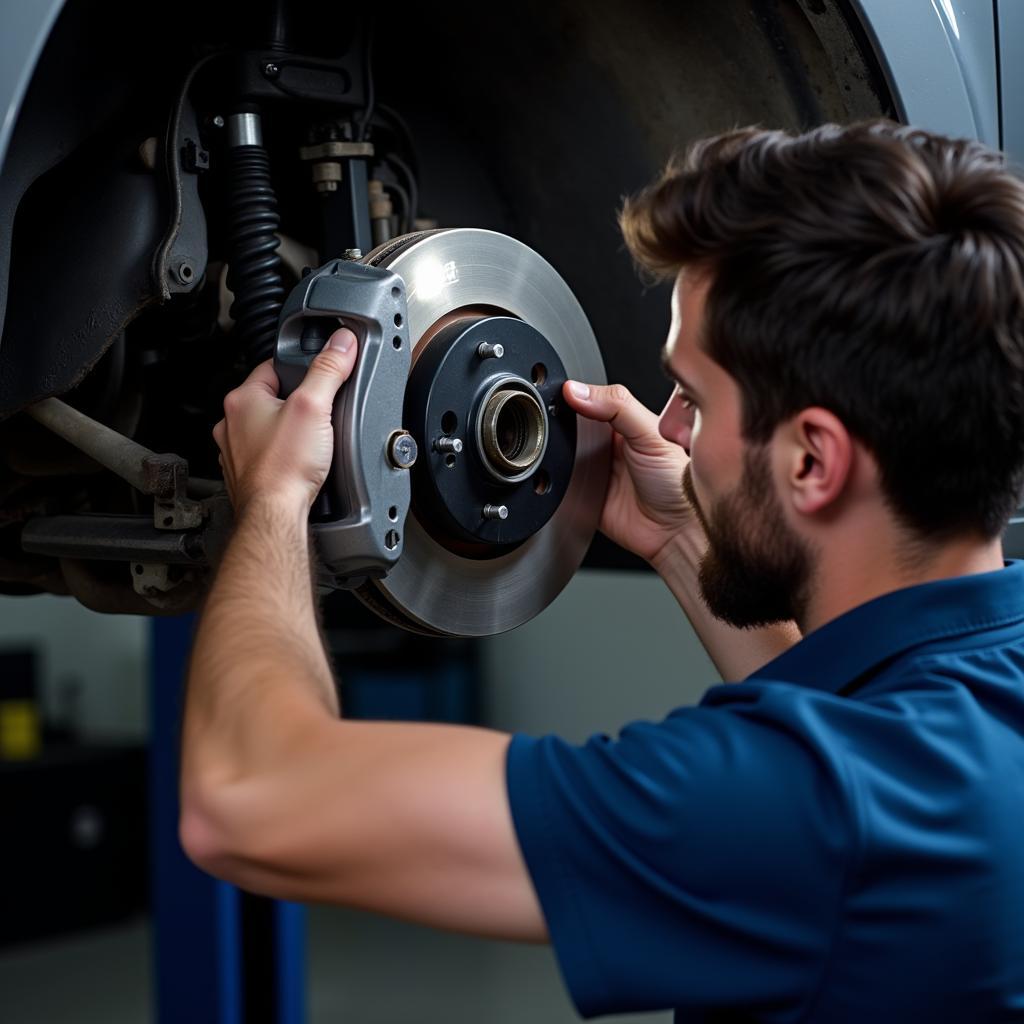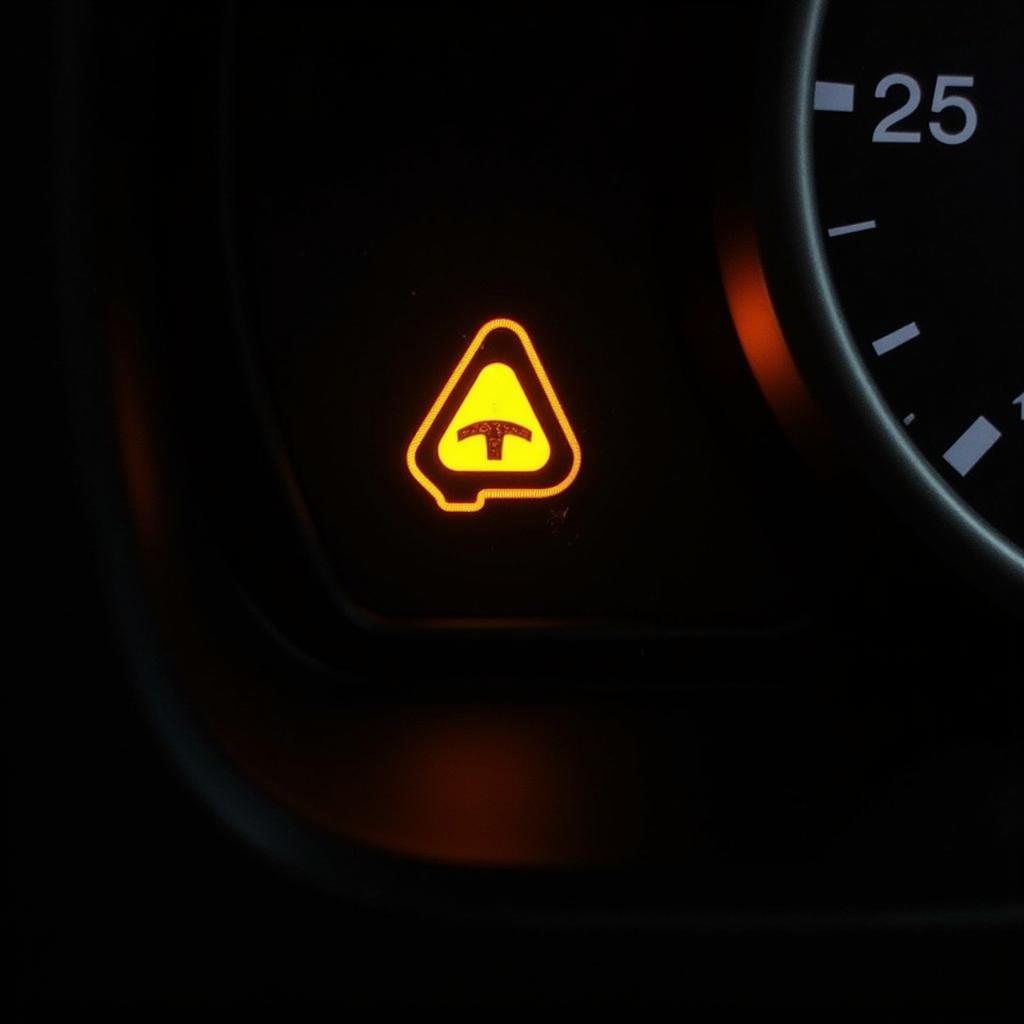The brake fluid warning light on your Seat Leon dashboard is a crucial safety indicator that should never be ignored. It typically illuminates as a red circle with an exclamation mark in the center or a parenthesized “(!)” symbol. This light signals a potential problem with your car’s braking system, which could compromise your ability to slow down or stop safely.
This comprehensive guide will delve into the common causes of the Seat Leon brake fluid warning light and provide you with a step-by-step approach to diagnose and address the issue.
Understanding Your Seat Leon’s Brake Fluid Warning Light
Your Seat Leon’s braking system relies on hydraulic pressure to function correctly. When you press the brake pedal, brake fluid amplifies this force, acting on the calipers to push the brake pads against the rotors and slow down or stop your car. The brake fluid warning light is directly connected to the brake fluid level sensor in your car’s reservoir. When the fluid level drops below a safe threshold, the sensor triggers the warning light on your dashboard.
Common Causes of a Seat Leon Brake Fluid Warning Light
While a drop in brake fluid level is the primary trigger for this warning light, several underlying issues could be responsible:
-
Worn Brake Pads: As brake pads wear down over time, the brake calipers need to extend further to engage the rotors. This extension requires more brake fluid, leading to a drop in the reservoir level.
-
Brake Fluid Leak: Leaks can occur in various components of the brake system, including the master cylinder, brake lines, hoses, and calipers. A leak will lead to a gradual loss of brake fluid, triggering the warning light.
-
Worn Brake Caliper Seals: The calipers contain seals that prevent brake fluid leakage. Over time, these seals can deteriorate, causing fluid to escape and activating the warning light.
Diagnosing the Issue: A Step-by-Step Guide
Before attempting any repairs, it’s crucial to identify the root cause of the brake fluid warning light. Here’s a step-by-step guide:
-
Check the Brake Fluid Level: Park your Seat Leon on a level surface and engage the parking brake. Locate the brake fluid reservoir; it’s typically a translucent plastic container with a black cap, situated towards the rear of the engine bay on the driver’s side.
-
Inspect the Reservoir: Carefully remove the reservoir cap. Most reservoirs have “Min” and “Max” level markings. Check if the fluid level is below the “Min” mark. If it is, you’ll need to top up the brake fluid.
 Checking Seat Leon Brake Fluid Level
Checking Seat Leon Brake Fluid Level
-
Look for Leaks: If the brake fluid level is low, inspect all visible brake components for any signs of leaks. Pay close attention to the areas around the master cylinder, brake lines, hoses, and calipers. Look for wet spots, drips, or a damp residue.
-
Assess Brake Pad Wear: While inspecting for leaks, visually examine your brake pads through the spaces between the wheel spokes. If the pads appear significantly thin or you can’t see them at all, they are likely worn and contributing to the low brake fluid level.
What to Do When the Brake Fluid Warning Light Comes On
If your Seat Leon’s brake fluid warning light illuminates, it’s crucial to take immediate action:
-
Pull Over Safely: As soon as it’s safe, pull over to the side of the road and stop your car. Continuing to drive with low brake fluid or a brake system leak can lead to brake failure.
-
Do Not Drive: Avoid driving your Seat Leon until the issue has been diagnosed and resolved. Driving with compromised brakes puts you and other road users at risk.
-
Seek Professional Help: If you’re uncomfortable performing the checks yourself or suspect a leak or other issue, it’s essential to contact a qualified mechanic or your Seat dealership for immediate assistance.
 Seat Leon Brake System Inspection
Seat Leon Brake System Inspection
Maintaining Your Seat Leon’s Braking System
Regular maintenance is key to preventing brake fluid warning light issues:
-
Regular Brake Fluid Flushes: Seat recommends flushing your brake fluid every 2 years or as per your car’s service schedule. Brake fluid is hygroscopic, meaning it absorbs moisture over time, reducing its effectiveness.
-
Timely Brake Pad Replacement: Worn brake pads are a common cause of low brake fluid levels. Replace your brake pads as soon as they reach their wear limit.
-
Address Leaks Promptly: If you notice any signs of a brake fluid leak, don’t delay getting it fixed by a qualified mechanic.
Conclusion
The brake fluid warning light in your Seat Leon is a critical safety indicator that demands immediate attention. By understanding its causes and following the steps outlined in this guide, you can diagnose and address the issue promptly. Remember, regular maintenance and timely repairs are crucial for ensuring a safe and reliable braking system. If you’re ever in doubt or uncomfortable performing checks or repairs yourself, contact a qualified mechanic or your Seat dealership for assistance.
FAQs about Seat Leon Brake Fluid Warning Light
1. Can I drive with the brake fluid warning light on?
No, it’s highly dangerous to drive with the brake fluid warning light on. This indicates a potential issue with your braking system, which could lead to brake failure. Pull over safely and seek professional help immediately.
2. How often should I check my Seat Leon’s brake fluid level?
It’s a good practice to check your brake fluid level at least once a month and before any long journeys. This will help you identify any potential issues early on.
3. What type of brake fluid does my Seat Leon use?
Refer to your owner’s manual for the recommended brake fluid type and specifications for your specific Seat Leon model. Using the incorrect type of brake fluid can damage your braking system.
4. Can I top up my Seat Leon’s brake fluid myself?
Yes, you can top up the brake fluid yourself. However, it’s essential to use the correct type of brake fluid and avoid spilling any on painted surfaces. If you’re unsure, consult a mechanic.
5. How much does it cost to fix a brake fluid leak?
The cost of repairing a brake fluid leak can vary widely depending on the location and severity of the leak. It’s best to contact a mechanic for a quote.


